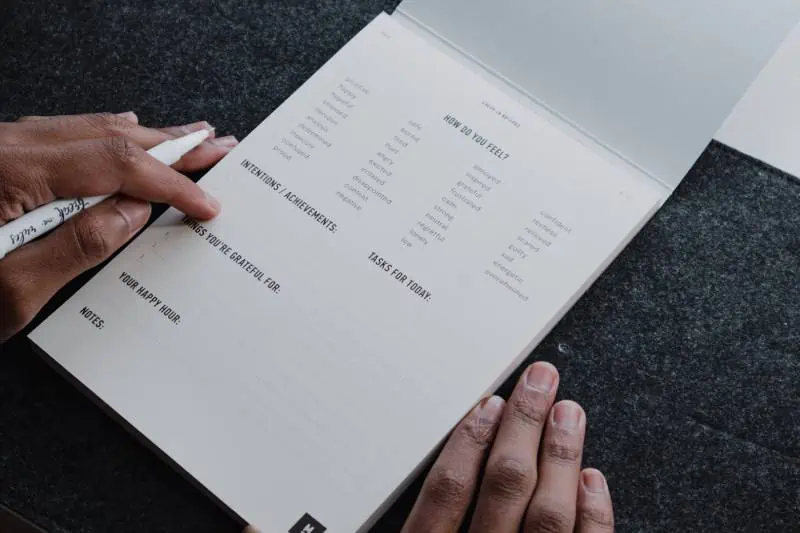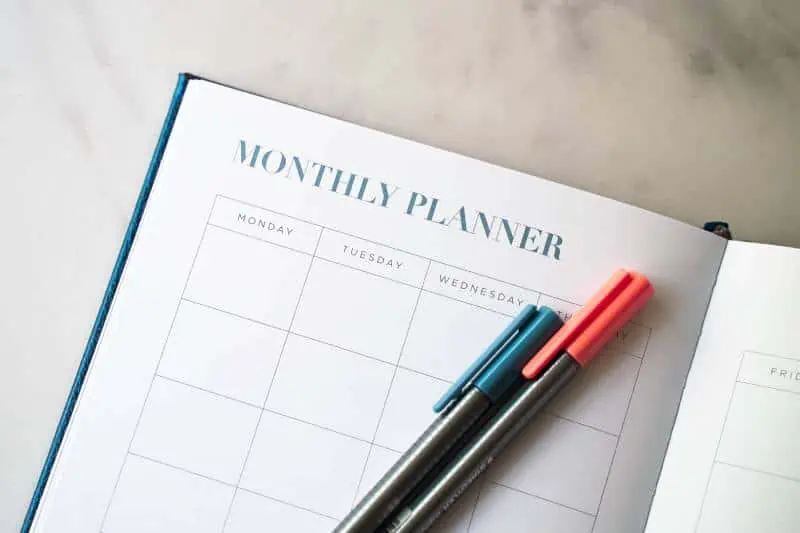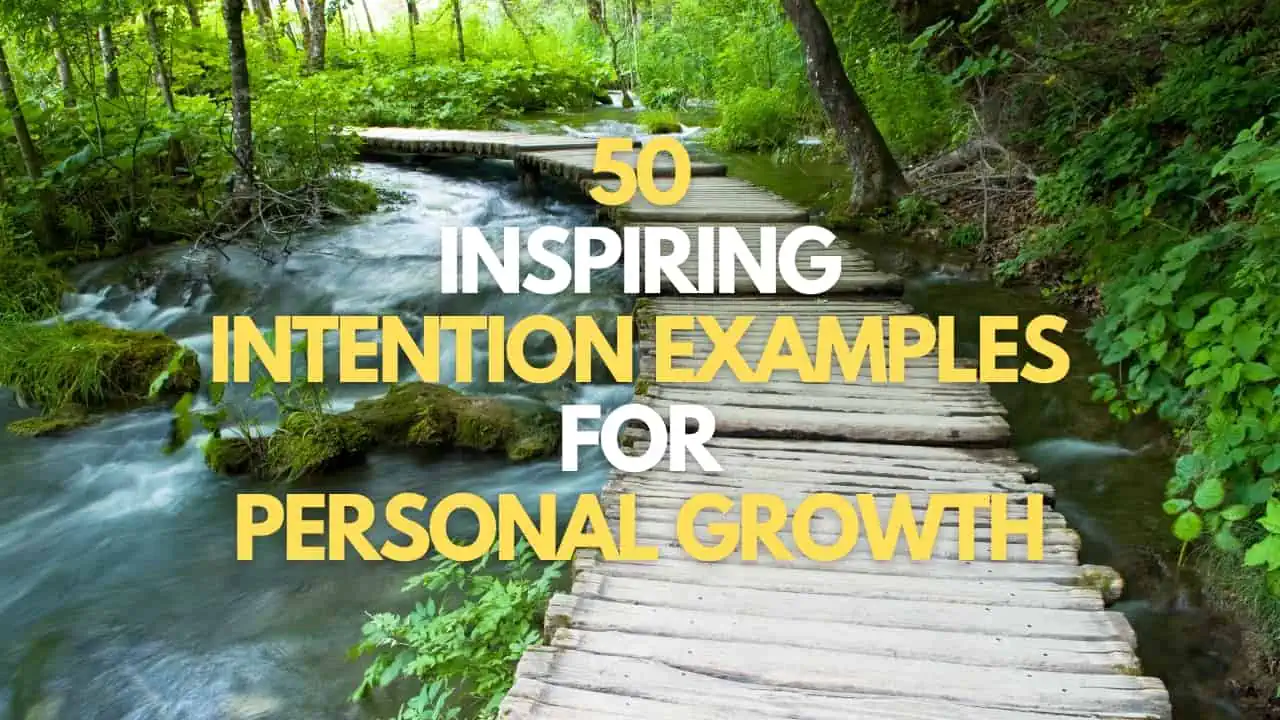Listen to this article:
Key Takeaway
Setting daily intentions connects you to your purpose and focuses your day for success and fulfillment.
Intentions are widely used both in the spiritual and personal development worlds. In particular, daily intentions are a popular part of a morning routine. They are practiced by a broad range of people, from business owners to athletes to working mums to yogis.
Setting intentions for the day sets you up for a positive day, helps you stay focused in your daily life, and keeps you connected to your true purpose. When we take time to set daily intentions, we can recognize areas of our lives we are neglecting and take action to prioritize them.
To help you understand what intentions are, we’re sharing some common intentions examples for daily, monthly, and yearly resolutions. We’ll also share a few tips on how to set powerful intentions that will manifest into reality.
Prefer video? Here’s a good recap of this article we made for Youtube:
Contents
- 1 What is a Daily Intention?
- 2 The Science Behind Intention Setting
- 3 Daily Intention Examples
- 4 Examples of Monthly Intentions
- 5 Examples of Yearly Intentions
- 6 How to Set Intentions to Manifest Happiness Naturally
- 7 Incorporating Daily Goals into Work-Life
- 8 Tips for Achieving Your Daily Goals
- 9 Final Thoughts on Setting Intentions
What is a Daily Intention?

A daily intention is a powerful tool for setting yourself up for success each day. By setting intentions each morning, you connect to your purpose and understand what you need to focus on to move forward in your life.
Without setting daily intentions, we can easily slip into living on auto-pilot. This is where we go about our daily tasks without knowing why we are doing them, or in other words, what we are working towards.
Typically a daily intention is a phrase you repeat to yourself and write out each morning before starting your day. However, your intention can simply be a word that represents your focus or priority for the day, such as self-love.
Setting intentions differs from creating goals, but they both help us cultivate more clarity around what we want. However, while goals should be specific and follow the SMART framework, daily intentions can be broader. This is because they do not have a particular end result like goals.
The Science Behind Intention Setting

As setting intentions is popular in spiritual practices like yoga and meditation, it can be easy to assume that it is simply “woo-woo.” However, scientific research has shown that the energy of thought can alter the environment, which in other words, means there is power in our thinking. This is because our intentions operate as highly coherent frequencies capable of changing the molecular structure of matter.
The research Lynne McTaggart carried out in her book “The Intention Experiment” states the same thing, that our thinking changes the states of all around us. This suggests that you are changing your physical reality by setting daily intentions. Thus your intent determines how your day goes.
Setting an intention can also change the neural pathways in our brains, which can alter our behaviors and habits. For example, if we set an intention to meditate every day, we are much more likely to follow it through than if we didn’t make the intent. Neuroplasticity occurs every time we repeat a new habit or behavior, creating and cementing that new neural pathway.
Daily Intention Examples

When setting a daily intention, it is best to start your resolve with “Today, I intend…” Daily intentions can be more specific than monthly and yearly ones as you set them for the short term. Here are some examples to get you started with setting daily intentions.
- Today, I intend to see the beauty around me
- Today, I connect to the present moment
- Today, I cultivate and spread positive energy
- Today, I intend to make someone smile
- Today, I intend to express my gratitude
- Today, I nourish my body with healthy food and exercise
- Today, I protect my energy by setting boundaries
- Today, I intend to do something that scares me
- Today, I intend to make time for myself
- Today, I intend to show my partner I love them
- Today, I intend to do a random act of kindness for someone
- Today, I look for ways to help or assist others
- Today, I intend to drink lots of water
- Today, I intend to rest
- Today, I intend to do something fun
- Today, I speak kindly to myself
- Today, I practice patience with my children
- Today, I intend to connect to nature
- Today, I intend to pause before reacting
- Today, I intend to learn something new
Examples of Monthly Intentions

Monthly intentions can be specific, such as if we want to start a new hobby, create a particular habit, or stop self-destructive behavior. Or they can be more general, such as if we want to prioritize or focus on one area of our life or cultivate more of a particular quality.
Some monthly intentions may be similar to or the same as one of your past daily intentions. For example, you may have set a daily intention to rest more. However, perhaps you realize that your energy is hugely depleted; thus, you need to slow down for a more extended period.
Here are some powerful intentions you can use when planning for the upcoming month. Some of these intentions examples can also be altered to use for the forthcoming week instead.
- This month I prioritize self-care
- This month I intend to practice mindful living
- This month I intend to meditate every day
- This month I experience more joy in my life
- This month I intend to love unconditionally
- This month I stay mindful during stressful and busy times
- This month I forgive others that have recently hurt me
- This month I intend to stick to my yoga practice
- This month I intend to learn a new skill
- This month I intend to start a new class/course
- This month I intend to read a book from start to finish
- This month I stop taking things personally
- This month I say no to things that don’t serve me
- This month I make healthier food choices
- This month I intend to not check my phone first thing in the morning
Examples of Yearly Intentions

When setting yearly intentions, think long-term. This means choosing a resolution that is not too specific and can evolve as the year progresses. For example, your intent for the year could be to experience gratitude. It may start as “I intend to be more grateful for the things in my life.”
As you cultivate this thankfulness, you may decide to change it to “I intend to express my gratitude every day.” It could evolve further into “I intend to inspire others with my attitude or gratitude.” Here are some other examples of good intentions for the new year.
- This year I develop a healthy relationship with money
- This year I live an authentic life aligned with my beliefs
- This year I intend to find and follow my purpose
- This year I take aligned action to move closer to my life goals
- This year I intend to increase my income to live a better life
- This year I intend to put my well-being above everything else
- This year I prioritize personal development to discover my most authentic self
- This year I intend to stay connected to nature by taking weekly walks or hikes
- This year I intend to stay committed to my spiritual practice
- This year I intend to discover and explore new parts of myself
- This year I choose peace and love over hate and conflict
- This year I surrender to all the things I cannot control
- This year I intend to make conscious decisions to make the world a better place
- This year I stand in my power and achieve my dreams
- This year I seek out joy in the little things
How to Set Intentions to Manifest Happiness Naturally

If you’re new to intention setting, you may wonder, “what is the best way to set an intention.” Here are a few ways to set your own intentions that lead to a future you dream of.
- State it in the present tense
Your intentions should be framed in the present tense and worded as absolute. Avoid using the phrase ” I want to,” as this carries too much uncertainty. In addition, refrain from using “I will” as it is based too much on the future. When you set an intention, even if it is for the year ahead, your resolve starts from the moment you state it, not in one week, so always speak from the present moment.
- Ensure it has a positive tone
Your intentions should always focus on what you want to achieve or how you want to feel, not what you want to avoid. Why is this? Because when we set intentions, the universe conspires with us. However, the universe only understands the energy of words, not their order.
So if you intend to feel less stressed, the universe may not understand that you desire less of it and thus, will assume you are seeking stress. So to make your intentions clearer, refrain from using pessimistic words to avoid confusion. So if you want to reduce your stress, change your intent to “my intention is to experience more peace and calm.”
- Write it down
The most powerful intention is one that is on paper. When you write your intent down, you take the idea from your mind and cement it into the physical world. Writing our intentions is an act of declaring them.
If you set daily intentions, using an intention journal can be an excellent way to record your insights and reflect on your resolutions over the year. A digital alternative is to record them each morning in the notes section on your phone.
- Keep your monthly and yearly intentions where you will see them
We recommend writing your monthly or weekly resolve on a sticky note and attaching it to the fridge or mirror to regularly refresh the mind of your focus. Having your intention somewhere you will see it often will help you stay accountable and prevent you from going off track.
Post-it notes can be a good idea when setting intentions for the year ahead, but they will likely not last the entire year. So instead, opt for a longer-lasting solution that you will see often. One idea is to create a graphic of your intention on Canva or a similar app and set your design as your phone or laptop’s wallpaper or screensaver.
This way, whenever you look at your phone or turn on your laptop, you’ll be reminded of your focus.
Incorporating Daily Goals into Work-Life
Many people associate goals with spiritual aspects of life. However, they also play a role in our endeavors. It has made an impact on my approach. Let me explain how this practice can be beneficial.
To begin with, establishing a goal before starting work can influence our mindset for the day. It’s akin to setting the mood for a meeting. On a scale for your workday.
For instance, my goal could be something like “Today I aim to tackle each task with creativity and an open mind.” This simple declaration can reshape how I handle my projects.
Furthermore, goals can enhance interactions with coworkers. Setting a goal such as “Today I aim to listen and show empathy in all my discussions” can have an effect. It’s not about actions; it’s also about fostering connections with others.
Lastly, goals can assist us in managing stress levels. During these days, my usual goal is to “maintain composure and stay collected regardless of the challenges that come my way.” It serves as a reminder that I have control over how I respond to pressure.
However, it proves to be an approach to boost efficiency, foster better connections at work, and handle stress effectively. I’ve personally experienced its influence on my life, and I’m confident it can benefit others as well.
Tips for Achieving Your Daily Goals
Once you’ve set your goals for the day, the next challenge is turning them into reality. Many of us struggle with this step. It’s one thing to say, “Today I want to be more patient ” but putting it into practice is a story. How can we bridge this gap?
Ensuring Your Goals Stick
Firstly, it’s important to keep your goals at the forefront of your mind throughout the day. It’s easy to lose sight of our morning intentions when life gets hectic.
One strategy is to set reminders on your phone. These reminders can be notifications that pop up a times during the day, serving as gentle prompts to remind you of your goals.
Next, try visualizing yourself pursuing your goals. If your goal is to listen, picture yourself engaged in conversations and truly focusing on what others are saying. How does it feel? What do you observe? Visualization prepares your mind to align its actions, with your goals.
Lastly, take time each evening to reflect on how you lived up to your goals throughout the day. Were there moments when you forgot about them? Instances where remembering made an impact? This reflective practice helps reinforce your goals. Allows you to learn from each experience.
By following these guidelines, you can transform your thoughts into deeds. Through repetition they will seamlessly integrate into your routine.
Final Thoughts on Setting Intentions

Setting intentions can help you gain clarity, connect to your purpose, and stay focused on what truly matters. The intention examples in this article will help you start setting intentions to create a life aligned with your beliefs.
Pop quiz! 🧘🤔
Setting daily intentions requires a lot of time.
Intentions and goals are the same things.
Writing down your intentions can make them more effective.







